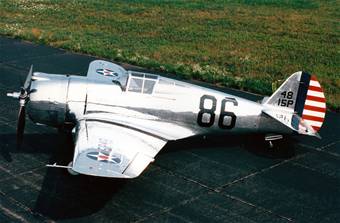![]() The Pacific War Online Encyclopedia
The Pacific War Online Encyclopedia
|
| Previous: P-35, U.S. Fighter | Table of Contents | Next: P-38E Lightning, U.S. Fighter |

Curtiss P-36C Hawk
| Crew | 1 |
| Dimensions | 28'10" by 37'9" by 9'6" 8.79m by 11.50m by 2.90m |
| Wing area | 236 square feet 21.9 square meters |
| Weight | 4620-6150 lbs 2100-2790 kg |
| Maximum speed | 300 mph (483 km/h) at 10,000 feet (3050 meters) 272 mph (438 km/h) at sea level |
| Cruising speed | 200 mph 322 km/h |
| Landing speed | 75 mph 121 km/h |
| Climb rate | 47 feet per second 14.3 meters per second |
| Service ceiling | 33,000 feet 10,000 meters |
| Power plant | 1 1200 hp (895 kW) Pratt and Whitney R-1830-17 Twin Wasp 14-cylinder two-row engine driving a three-blade constant-speed Curtiss propeller. |
| Armament | 1 0.50 fixed
cowling machine gun (200 rounds) 1 0.30 fixed cowling machine gun (500 rounds) 2 0.30 fixed wing machine guns (500 rounds) |
| Range | 670 miles (1080 km) on internal fuel 1010 miles (1630 km) with fuselage tank |
| Fuel | 87 gallons (320 liters) internal 48 gallons (182 liters) in optional fuselage tank |
| Production |
1424 of all models. 177 P-36A, at least 33 P-36C at Curtiss-Wright Airplanes Division, Buffalo, NY. A small number were assembled overseas,
including 20 in Argentina, 30 or 40 in China
(CAMCO) and 5 in India (Hindustani
Aircraft). |
| Variants |
The P-36A used a 1050 hp (783 kW) R-1830-13 and lacked the wing guns. The Hawk 75 was an export version using an R-1820 engine and fixed landing gear. These were sold to Argentina, Thailand, and China. The Hawk 75A used the more powerful R-1830
and was sold in large number, 350 reaching France before the capitulation. |
Although a capable aircraft by the
standards of 1940, and a thorn in the side of the Japanese in China before the arrival of the Zero, the
P-36 Hawk was obsolete by the time war broke out in the
Pacific. In
particular, its lack of any kind of supercharger greatly limited its
high-altitude performance, and its combat radius was only about 225
miles. Its retractable landing gear were excessively complicated to avoid paying royalties on a more modern design.
The design came out of an Army Air Corps
competition to design a modern monoplane fighter. The prototype flew on
15 May 1935, but the Air Force awarded the competition to the P-35 Seversky instead. Curtiss replaced the
original R-1820
with a more powerful Twin Wasp, demonstrating the prototype in February
1937 and winning a production contract shortly after. France ordered a
large number of the Hawk 75A export version, and 350 of these aircraft
claimed 311 Luftwaffe victims in the battle of France. The remainder of
France's order of 620 went to Britain
as the Mohawk.
A number of these aircraft were present in
the Philippines,
Hawaii, and the
mainland, and saw some combat, in which they were usually outmatched by
the Zero
fighter. However, P-36s
claimed two enemy aircraft at Pearl
Harbor.
References
The Pacific War Online Encyclopedia © 2007, 2009, 2014-2015 by Kent G. Budge. Index